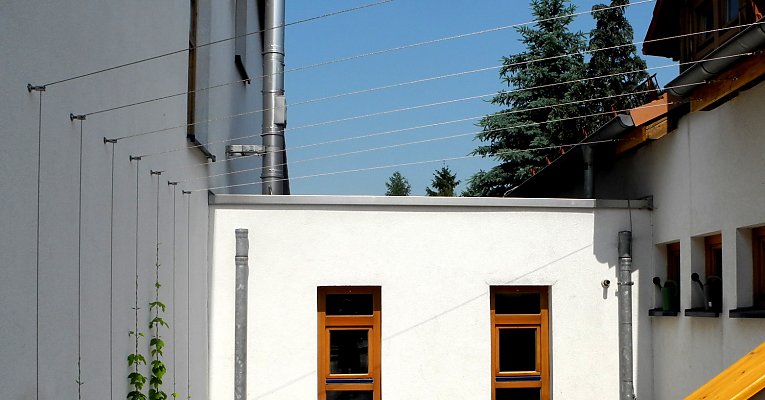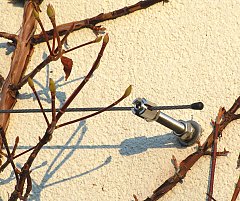Tension Ropes as Trellises: Planning
FassadenGrün sells lattice trellises and wire rope trellises, both made of stainless steel. In this section you can find all you need to know about the latter. Tension cables as trellises are graceful and more flexible than rigid trellises, just as sturdy, and less obtrusive. When are they most useful? Which wire rope arrangement / design is suitable when? Which construction style (light, medium, heavy...) should be used when? How do I know which cable system is best for my climbing plant? Which is better: a pre-assembled trellis kit or my own assembly from components? How important is distance from the wall? Are all wall surfaces suitable? Do I have to use stainless steel?
We offer answers here as well as other tips on choosing an optimal climbing aid for your plants. Stainless steel is highly recommended; with a lesser quality metal, you can expect damage and rust.

Using Tension Cables
Climbing plants have different strategies for moving up a vertical support. Wire ropes function in a variety of ways, depending on a plant's strategy, that is, growth habit.
Initially, they serve as a ladder for young shoots to grab hold of and climb. Twining plants twist and wrap their shoots directly around the cable, but a permanent entwining should only be allowed with light or moderately-twining climbing plants. (*Take care with vigorous twiners like wisteria, as they can develop very thick stems/trunks over time. With these plants, it is essential that their shoots be guided parallel to the cables; otherwise the trellis ropes may be distorted or trellis mounts pulled from the wall.)
Old or shrubby plants ~ perennial plants that develop a thick, woody trunk ~ are attached to a trellis with ties. They should be trained in front of the cable trellis to allow aeration of the leaf mass; young shoots can be tucked behind the cables and pruned later.
Sometimes wire ropes serve as a template to give a plant a particular shape; that is, the plant is strictly trained along those cable lines.
Wire ropes can also be used to hold some self climbers (like ivy) in place, acting as ‘fall protection,' for example in the case of strong winds, when whole mats of greenery can be torn from a wall. See our photo gallery below for examples.
In FRONT of or BEHIND the Trellis?
When possible, the plant should always be placed and guided in front of the support (trellis) system. This allows proper ventilation, without which, the plant is quite susceptible to mold. The 'old wood' (older vines and branches) are tied and bound (see link for binding material) to the supporting wire ropes.
If the purpose of the cable trellis is to prevent a plant from falling off the wall ('fall protection'), then the shoots can and will interweave with the cables and may grow behind them. Young green shoots that do not become part of the main branch framework can become caught behind ropes. These shoots are then removed during the pruning periods.
Wall Distance
A climbing aid (wire rope support system) should help the plants grow upward and allow them to breathe by leaving sufficient space between the leaf mass and the facade. People have a tendency to go with overly excessive cable tension techniques or overestimate the number of cables needed.
What is important in the initial development phase of the plants later plays only a minor role. As plants grow and age, they catch, entwine, and anchor themselves with their own shoots; the young shoots will no longer depend on the cables to climb. They will naturally move towards the light and therefore towards the outside, which will automatically create an 'empty' space between the vegetation and the facade. The purpose of the trellising system is above all to support the trunk of the plant. Our medium trellis system ('medium kit')- with a 5 cm distance between the wall and the plant- is sufficient in most cases. For more information, see the sections on wire rope systems provided under our individual climbing plants.
Building Corners and Offsets
If you want to trellis one plant on two different sides of the same building (guide plants around building corners), two separate climbing aids have to be mounted on each wall for stability reasons. The gap is bridged with the vines' own shoots. Even stouter, thicker shoots can also be led around the corner in this way. The same applies to horizontal projections or offsets, like ledges, etc..
Single Strands or Grids?
Some particularly vigorous twiners, like wisteria, should really only climb a single cable to facilitate pruning and care. For most plants, however, larger, planar arrangements make more sense. A design question arises: shall the tension ropes be arranged individually as parallel lines, or is a grid-like lattice structure (with vertical and horizontal axes) better? For architectural reasons, it may be necessary to opt for a parallel cable arrangment without any intersescting axes. This applies equally to horizontal and vertical lines. Such climbing aids can appear sleeker, more pleasing, and often harmonise better with the design language of the building. For the plants themselves, however, grid arrangements offer more 'grip' and are therefore generally preferred. You will find both options ~ in myriad variations ~ under our wire rope systems.
Choosing a Wire Rope Trellis
Ideally, you already know what you would like to see growing on your facade... if so, find your respective chosen plant in our climbing plants section. There, in the chart at the bottom of each plant profile, you can find the most suitable cable trellis shapes for that plant. Choose an arrangement ('wire rope system') fitting to your situation. The next step is to choose a construction style (easy, medium, heavy, massive...).
If, for whatever reason, you have not decided on a specific plant yet but wish to quickly assemble a trellis system, we have developed universal systems for you that are compatible with almost every plant (with the exception of vigorous twiners like wisteria): 1030, 4030, 5030, 5040, 7020, 7050, or 8010.
Wire Rope Trellises in Various Construction Styles
A word in advance: when it comes to climbing aids, there is really no viable alternative to stainless steel. Other materials invariably cause damage of some sort sooner or later. Wire rope technology from FassadenGrün is made exclusively of high grade stainless steel. We offer five different construction styles (guages) for our cable trellises: easy, light, medium, heavy, and massive. Basically, all of our pre-assembled wire rope systems -- 'kits' -- are available in these five styles, classified according to design, wall distance, load-bearing capacity, and price. Again, refer to the charts at the bottom of each climbing plant profile, to see which construction style is a good fit for your plant.
Kit or Composition of One's Own?
Many applications can be fulfilled with our pre-assembled cable trellis kits. Though all individual components are also available here for purchase, the kits cost the equivalent thereof, have all the necessary mounts included, and are user-friendly! Such pre-assembled trellis sets are suitable for all wall types with the exception of: insulated walls (ETICS), cladding, and thin-walled concrete elements. Alternatives can be found for these cases. To green particularly large wall surfaces, we recommend zoning it into several smaller greening fields and mounting a few standard-size cable trellises next to each other.
You can also modify and enlarge basic shapes by ordering individual parts to supplement a kit. We can advise you on how to enlarge a facade greening, or let us know when you place an order what your needs are. You can also refer to our section on climbing plants; the charts at the bottom of each plant profile will show you which trellis forms (mounts, etc..) are best for the plant in question. Here you may find arrangements you prefer for your special case, depending on your preference for more dense or spartan, horizontal, or vertical forms. With this knowledge, you can put your own kit together from individual parts found in the section: components for wire rope systems. The mounts you choose should have approximately the same wall distances as a comparable wire rope system would have.
Preventing Damage
Some plants can cause considerable damage to buildings or wire rope systems. Please take precautions! Vigorous climbing plants (like wisteria) need special attention, especially on wire rope trellises.

Application Scenarios
Here you can see how different wire ropes can be used to create climbing-plant supports. For more inspiration, take a look at the photo galleries in our Ideas section.



























